|
Home
Welcome
Our Services
Benefits
How It Works
Schematics
Floor Diagrams
Renewable Energy
Heat Pumps
Case Studies
Single
Zone Packs
Gallery
Floor Coverings
Knowledge
Guarantee
UFH FAQs
Quotes
Myths & Legends
Roman Innovation
Who
We Are
Contact Us
|
As
the song says, "Where do I begin to tell the story of how
great a love can be?" Yes, heat pumps and underfloor heating
are truly a match made in heaven.
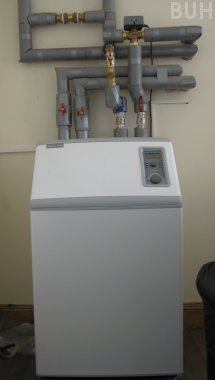
Ground
source heat pumps
Heat pumps take latent heat energy from the ground or outside
water and convert it into usable heat energy. They work like
a fridge in reverse and run on electricity, so they're not,
strictly speaking, a 'renewable' energy source. However, the
amount of electrical energy required to run them can be considerably
less than the usable heat energy they produce. A good heat pump
properly installed and running at peak efficiency can have a
heat output of up to five times the amount of electricity it
uses. This is known as the 'Coefficient of Performance' or COP.
Look for a heat pump with a high COP in its technical specification.
However, do not be misled by sweeping statements of efficiency.
Heat pumps are most efficient while providing warm water up
to around 35 deg C. Above this temperature, the efficiency,
and COP, will fall away dramatically, so if you are using the
heat pump to run radiators in a draughty old house, they could
be no more efficient than an oil boiler.
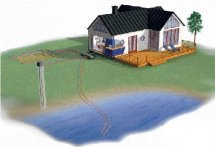
Surface
collectors
The most common method of extracting the heat energy from the
ground is through horizontal pipes buried a metre below the
surface. At that depth, the soil temperature is fairly stable
at around 10 -12 deg C. Surface collectors are the easiest and
cheapest means of extracting the ground heat.
Ground
probes
A ground probe, or borehole, can be used where there is insufficient
room to have a horizontal ground loop. A specialist drilling
company will need to be employed to drill the hole and insert
the probe. This makes a ground probe much more expensive than
a horizontal collector.
Ground
water
If a lake or large pond is available it can be used as a heat
source because the water temperature is always between 7 and
12 deg C all year round.
For
a diagram of these scenarios, please click here.
|
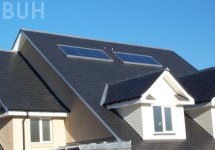
Solar
water heating
This is the most popular and cost effective way of capturing energy
from the sun. Solar water panels are usually mounted on the roof
of a building, which is orientated as near towards the south as
possible, to derive the greatest benefit from the midday sun.
Water is circulated through the panels and the heated water passes
through a coil in the DHW cylinder where it heats the stored water
in the cylinder.
Solar water heating is most beneficial between April and September,
although a sunny day at any time of the year will provide a useful
amount of hot water. The area of panels required is determined
by the size of the hot water cylinder, which in turn is calculated
on the size of the property and the amount of hot water needed
each day. As a general rule, one square metre of panel is sufficient
for 60 litres of stored hot water, although this figure will vary
between manufacturers. Solar water heating only requires a small
amount of energy to operate the circulating pump, although some
systems have an integral solar powered pump that starts to operate
when the sun is shining, so does not require an electrical supply.
Solar
photovoltaic cells
Solar electric (photovoltaic) panels mounted on the roof convert
sunlight into electricity. A large surface area is required to
capture enough energy to be worthwhile, but these panels are currently
very expensive to install. The price is likely to fall as product
development improves efficiency, and demand increases production.
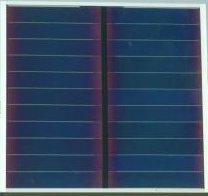
Hydro
Small
domestic sized hydro generators are available, but are only suitable
in applications where there is a sufficient constant flow of fast
running water with a fall of preferably not less than one metre;
a higher fall, and large volumes of water, would provide a greater
amount of energy. Anyone who does have a stream or burn running
through their property could certainly consider this option, and
if feasible, this could provide a reliable uninterrupted electricity
supply.
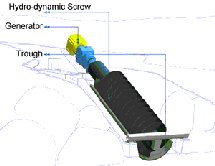
|
Air
source heat pumps
If
there is insufficient room for either horizontal ground loops
or a bore hole, then an air to water heat pump can be used. These
units are installed outside and convert the air temperature into
usable heat energy. Air to water heat pumps are not as efficient
as ground source heat pumps, but in a well insulated building,
they should be able to provide all the heating and hot water requirements
throughout the year. It is not unusual to dock an air source heat
pump with a conventional boiler, which would only come on during
the coldest weather when the heat pump cannot satisfy the demand.

Wind
A
roof-mounted wind turbine can generate a small amount of electricity
to offset the consumption from the grid, but this is unlikely
to be sufficient to make a house self sufficient in electricity.
For those people fortunate enough to have a windy site (and planning
permission) a mast mounted wind turbine could provide enough electricity
to satisfy a domestic demand. The obvious disadvantage of a wind
turbine is that it only produces electricity when the wind is
blowing, so you will still need to be connected to the grid or
have a back-up storage or generation facility. One of our clients
has a mast mounted wind turbine and a battery storage facility,
which has enabled him to be totally off the grid.
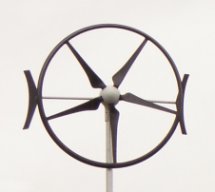
Back
boilers/Multiple sources
Wood
burning, or other stoves with a back boiler can be coupled to
a heating system via a thermal store, or buffer cylinder. The
volume of the thermal store must be big enough to prevent the
back boiler from overheating. A number of different heat sources
can be connected to the thermal store, which can then provide
hot water to the heating circuit.
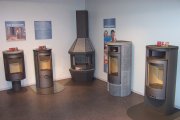
Schematic
diagrams of various plumbing arrangements of underfloor heating
with heat pumps and solar panels.
|